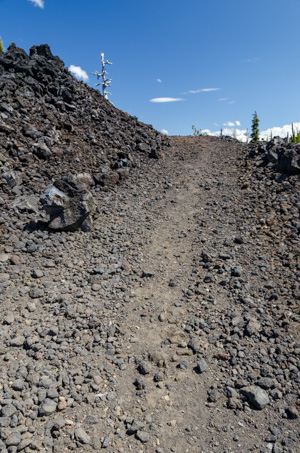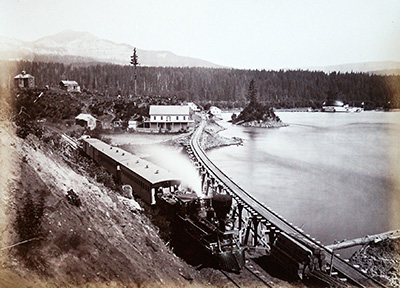Roads
 The Santiam Wagon Road near the Dee Wright Observatory in the lava fields on the McKenzie Highway 242. (Oregon State Archives Scenic Image D7K_1751)
The Santiam Wagon Road near the Dee Wright Observatory in the lava fields on the McKenzie Highway 242. (Oregon State Archives Scenic Image D7K_1751) Transportation improvements provided the key not only to overcoming nature, but to controlling it. Oregon’s environments presented a variety of transportation challenges, from the sheer size of the state to natural obstacles like rivers, mountains and canyons. These obstacles hindered the movement of people, ideas, goods and investment capital, slowing efforts to develop Oregon’s environments. Roads offered the first and generally least-effective measure for overcoming these challenges. Backed by investors and state charters guaranteeing a monopoly, private toll road companies transformed old trails and rough wagon paths into “improved” roads made of dirt tracks, planks and bridges. Some companies failed; the Portland & Valley Plank Road Company, for example, went bust within two years. Others thrived, especially when they received federal and state land grants to sell or lease, supposedly to help pay for what they called “military wagon roads.” In reality, speculators took most of the profits from the land grants, which totaled nearly 2.5 million acres, and farmers, not soldiers, primarily used the roads. That, after all, was the point: to move people, ideas, goods and capital more quickly throughout the state and accelerate the transformation of Oregon’s environments into profitable natural resources. But these connections were unreliable, difficult and slow, as bridges collapsed, planks decayed, and rain turned dirt paths into impassable mud pits. Oregonians seeking to get their products to market looked beyond wagon roads for their transportation solutions.
Waterways
Oregon’s waterways offered faster and easier transportation options, especially as they became better understood and even managed. By 1851, steam-powered ships traveled up and down the Willamette and Columbia rivers and cruised along the Oregon coastline, delivering wheat, wood and other products to internal and external markets, especially in San Francisco. But water transportation could be difficult, unreliable and dangerous. When European and American ships began plying the Columbia River in the early nineteenth century, they relied heavily on the expertise of Native guides to find their way around the river’s bars and other hazards. Throughout the 1800s, the U.S. government invested heavily in the safety and navigability of the Oregon coastline, building lighthouses and lifesaving stations and producing reliable charts of anchorages and safe passages into the Coos Bay estuary, Tillamook Bay, and other ports and rivers. Meanwhile, exploration and first-hand experience on the Columbia and Willamette rivers provided important information for shippers: the location of sandbars and other hazards, the routes through the rivers’ deepest and safest passages, and the times of year when water ran high and fast enough to allow transportation.
But knowledge of natural waterways was not enough. To increase the reliability and speed of water transportation, Oregonians changed waterways by deepening bars at harbor entrances, rerouting streams into straighter and faster canals, and using dynamite and specially-designed boats to remove snags and trees from rivers. There were significant limits, though: river transportation depended on rainfall and snowmelt to keep water levels high enough for boats and ships, major falls like those at Oregon City and The Dalles remained impassable, and eastern Oregon offered essentially no water transportation options. Waterways, like wagon roads, could only move Oregonians so far and fast towards their goal of controlling nature.
Railroads
 This Carelton Watkins photo shows a train at Upper Cascades on the Columbia River in the 1860s. (Oregon State Archives scenic photo)
This Carelton Watkins photo shows a train at Upper Cascades on the Columbia River in the 1860s. (Oregon State Archives scenic photo) Even as they built and maintained wagon roads and waterways, Oregonians eagerly anticipated the arrival of an even more powerful and transformative force: railroads. Railroads offered many promises to Oregonians eager to free themselves from the constraints of nature. While floods or low flow stopped water transportation on the Willamette River and other streams, and heavy rains washed out the Great Plank Road and other wagon roads, trains could run almost without regard to weather or season. Railroads could reach every corner of the state, including east of the Cascades where the lack of navigable waterways cut off farmers, ranchers, and other producers from markets. Most importantly, trains promised amazing speeds that seemed to smash through the natural barriers of time and distance. Within just a few years of statehood, railroads had spread through every region of Oregon: in 1862, the Oregon Steam Navigation Company built tracks along the Columbia River at the Cascades and Celilo Falls; the Oregon & California Railroad connected Portland to Eugene by 1871 and reached California in 1887; and in 1883, transcontinental train transportation came to Oregon via the Northern Pacific Railroad. As with wagon roads and water transportation, federal investment helped speed railroad construction: federal surveyors started exploring the best routes in the 1850s, and the federal government gave away millions of acres to railroad companies, including 3.7 million acres to the Oregon & California Railroad.
By the end of the century, 1,850 miles of railroad track crisscrossed Oregon, utterly transforming the state’s environments. This dramatic transformation was made possible by immigrants, first and most prominently from China, but also Greece, Italy, Japan and elsewhere. Construction crews built bridges across rivers and canyons and blasted away mountainsides to make room for railroad beds, ties and rails. Those wooden ties came by cutting and processing millions of trees from surrounding forests. Once built, the tracks allowed and encouraged Oregonians to accelerate environmental transformation: plant more wheat to send to distant markets, process more timber to transport on the railroads, and graze more cattle to herd towards rail shipping points. Trains carried not only the products of Oregon’s environments, but also the increasingly efficient and expensive agricultural equipment, logging machinery, and other industrial tools used to transform nature. And, of course, the railroads carried people: old and new immigrants, including people of color, moving through and throughout the state in pursuit of a better life. Along with water transportation routes, which remained vitally important, railroads helped incorporate Oregon, connecting farmers, ranchers, miners and loggers to land, resources and markets.
Next: Industrialization and Urbanization >